Why are my hydrangea leaves turning yellow? Hydrangea leaves show us through their changes that they may have something wrong with them. Interpret their symptoms, we help you! Learn all about Hydrangea Yellow Leaves – How to Fix Yellow Hydrangea Leaves.
Different factors influence the health of our Hydrangea plants. In this guide, we are going to talk about those that are related to the natural environment in which they are found. Let’s check out our Hydrangea Troubleshooting Guide for Yellow Leaves and How to Fix yellow hydrangea leaves
Table of Contents
Hydrangea Troubleshooting Guide for Yellow Leaves
Why are my hydrangea leaves turning yellow? This is our brief summary of the Hydrangea Troubleshooting Guide. In the following paragraphs, I explain in detail the causes of Hydrangea Yellow Leaves and How to Fix yellow hydrangea leaves.
- Yellow leaves due to Iron Chlorosis in Hydrangeas, characteristics are: yellow leaves and green nerves. It needs a greening product with iron chelates.
- Hydrangea Leaves turn yellow. This is a lack of light or fertilizer. If it does not recover with light, fertilize it.
- Dots, spots, and stains on yellow leaves. This is usually fungus and can be solved with sulfur. If there are few, it is best to cut them off.
Hydrangea Yellow Leaves
Hydrangea Yellow Leaves. When Hydrangea leaves turn yellow, we should normally monitor the watering, the acidity of the soil, and the fertilizer that we are giving to the plant in our garden or its pots. Let’s see what is happening with Hydrangeas and why leaves are turning yellow.
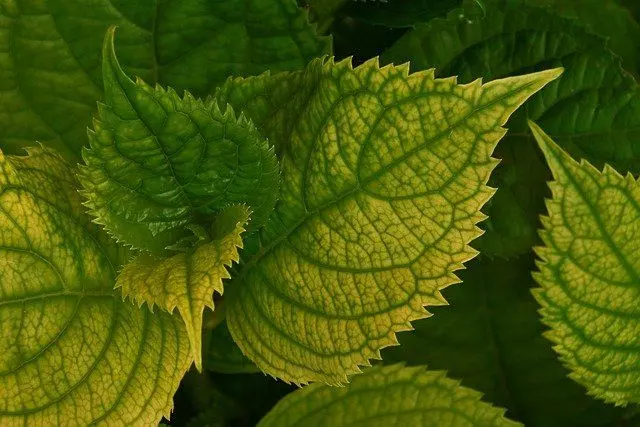
Hydrangea Yellow Leaves due to Iron Chlorosis
Why are my hydrangea leaves turning yellow? The hydrangea indicates that something is happening to it when it shows its leaves changing from green to yellow.
Yellow leaves due to Iron Chlorosis in Hydrangeas – Normally, this occurs because the pH of the soil is not what the plant needs, which causes difficulties in the absorption of iron.
The plant may be suffering from chlorosis, caused by a sudden loss of soil acidity or very calcareous watering (significant increase in pH).
Hydrangea Yellow Leaves due to Iron Chlorosis. By not absorbing iron, chlorophyll, the pigment responsible for the greenness of plant leaves, cannot be formed, so leaves tend to turn yellow, the main feature that denotes chlorosis.
Acid-soil plants such as hydrangeas are susceptible to chlorosis. When a hydrangea is healthy it has green leaves and flowers with intense shades; if it has chlorosis the leaves, instead of being dark green, will be tinged with yellow as in the photo, and more yellow every day.
Why are my hydrangea leaves turning yellow? Learn more about What is ferrous sulfate iron used for?
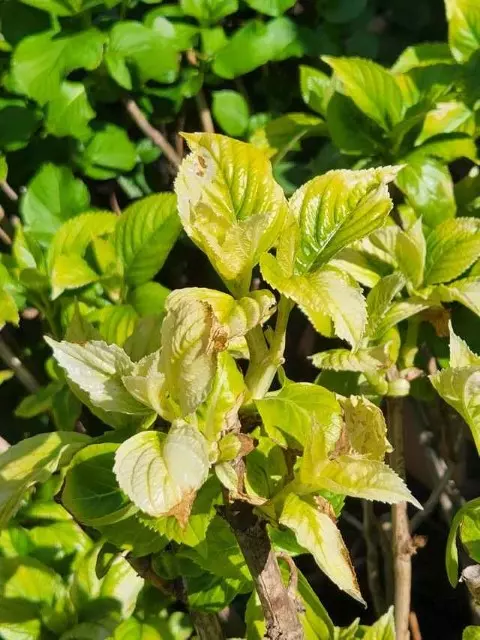
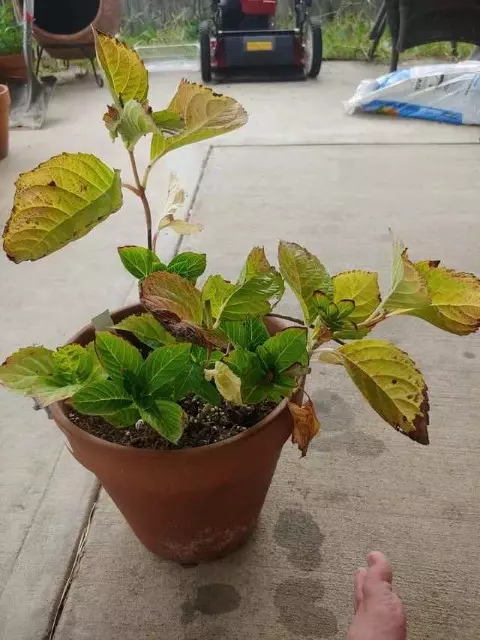
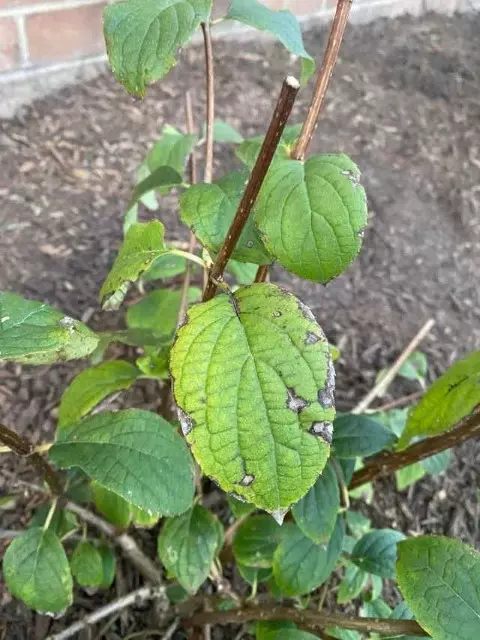
Hydrangea Chlorosis Treatment – How to Fix Yellow Hydrangea Leaves
Hydrangea Chlorosis Treatment – How to Fix Yellow Hydrangea Leaves. To correct this iron deficiency we can use specific products that provide the dose of iron that Hydrangeas need, such as iron chelate. Sprinkle the contents of the sachet at the base of the plant and then water the plant to absorb the iron content.
To solve the problem definitively we will also have to be careful not to water with hard water. To water these plants we will use rainwater, which does not contain any lime. And if the soils are calcareous, we will provide acid soils to avoid the problem.
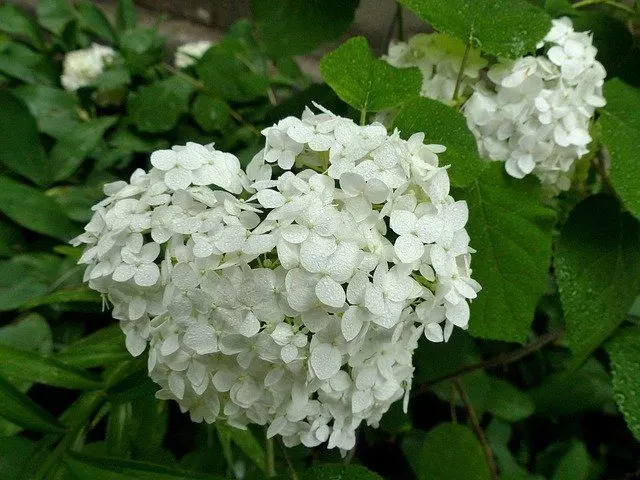
Why Do Hydrangea Leaves Turn Yellow?
Why are my hydrangea leaves turning yellow? Yellow Hydrangea leaves caused by chlorosis represent a significant loss of the ability of the plant’s roots to assimilate iron (Fe) from the soil.
The green leaves of Hydrangea, and plants in general, are closely linked to the assimilation of nutrients and minerals from the soil. Thus, any change in leaf color may indicate pathophysiology; in the case of chlorosis, it is a gradual change from green to yellow.
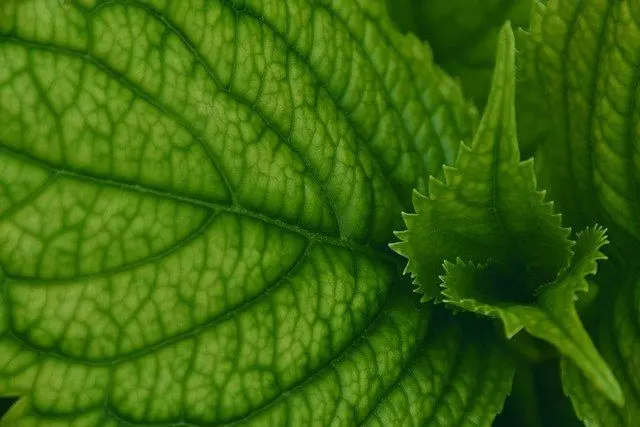
Hydrangea Chlorosis Treatment – How to Fix Yellow Hydrangea Leaves
To solve the change of color of the leaves of the hydrangea, we have to discard the options mentioned above.
So, first, we will check the acidity of the soil as the most important indicator, and then the type of fertilizer we are using to see if it is the correct one.
You should check the pH of your hydrangea with a pH meter like the one we use and it doesn’t need batteries, plus it has other functions that are very useful with plants (Order it here).
Remember that the colors of most hydrangeas depend on the balance between the acidity of the soil and the fertilizer used in their development and flowering. In general, it is advisable to use a specific fertilizer for acidic plants, but other types of fertilizers are acceptable as we saw in the article “How does the color of Hydrangeas vary according to the pH of the soil”.
The plant overcomes an episode of chlorosis thanks to the contribution to the soil of a specific product that provides the Iron (Fe) that it lacks, in a state easy for its absorption by the roots. This product is known as Iron Chelate and is usually administered by irrigation with non-calcareous water.
- GOODBYE YELLOW, HELLO LUSH GREEN LEAVES - Grow More iron chelate for plants is rich in organic ingredients, formulated to swiftly banish the yellowing leaves due to iron deficiency. Quickly notice the restoration of your plants' natural green color
- TREATS 2,000 SQUARE FEET - Gardening savvy meets cost-effectiveness with this ultra-concentrated formula giving you the most bang for your buck! Just mix with water following the recommended dosage, and enjoy numerous applications with this generous 8-ounce size
- VERSATILE FOR ANY ENVIRONMENT - Perfect for either indoor or outdoor spaces, our chelated iron fertilizer is most effective when applied to both soil and foliage, offering a flexible solution to combat iron deficiency with ease. Tailor its application to your plant's unique needs following our instructions for optimally healthy growth
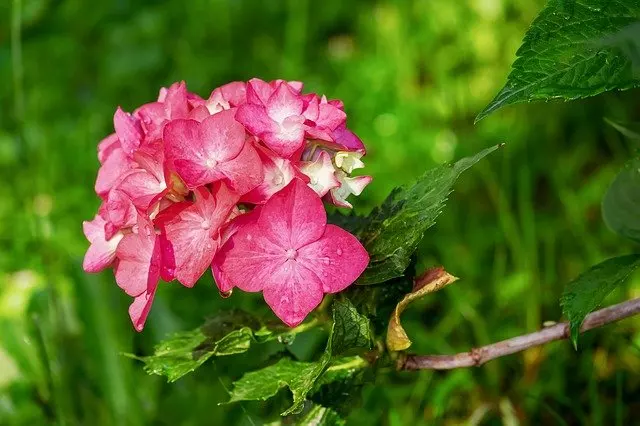
Hydrangea Yellow Leaves Due to Sun, Watering, Lack of Nutrients, Diseases, etc.
Now, let’s check out Other Factors That Can Cause Yellow Leaves on Hydrangea.
When we buy a Hydrangea plant and place it in our garden, on the patio, or on the terrace, we usually transplant it and place it following a very basic criterion: “Hydrangea is a shade plant”.
In most cases, it receives enough light and we have not been wrong, but sometimes, the amount of light the plant receives is not enough.
Hydrangea leaves can turn yellow due to insufficient light conditions. In this case, the solution is usually very easy, since it is enough to change the location of the plant.
Whenever we detect that the Hydrangea is not as it should be, it is a good habit to review and review the tips on How to care for Hydrangeas in the ground and potted Hydrangeas, to be more accurate in the diagnosis and fix the yellow leaves of hydrangeas. How to Care for Hydrangea – Complete Guide and How to Care for Potted Hydrangeas Outdoors

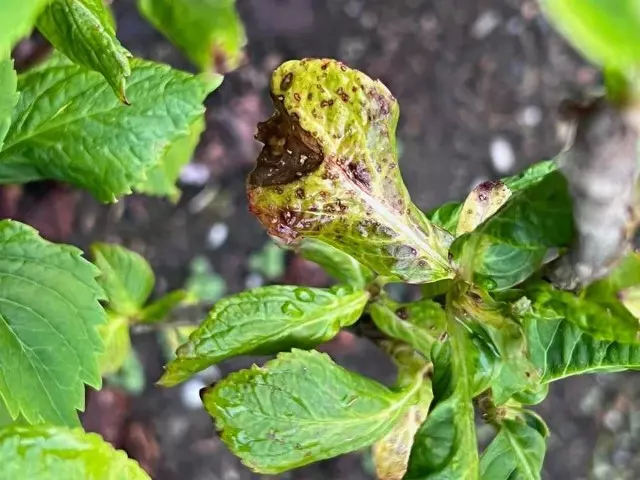
In these pictures above, it appears that there is a sulfur deficiency based on the appearance of the center hydrangea yellow leaves (which have already gone from yellow to brown in a week). Because the leaves become yellow, it’s easy at the beginning to confuse sulfur deficiency with nitrogen deficiency in hydrangeas or confuse it with chlorosis.
The sections that started to turn yellow, on the other hand, immediately turned brown, and the tips turned brown, extremely dark, and died quickly. This issue only occurs on the “older” leaves of hydrangeas with phosphorus shortage, not on the newer leaves.
If you don’t fix these hydrangeas’ yellow leaves by applying a suitable fertilizer for hydrangeas and regulating the soil pH, it will soon impact the entire plant, since hydrangeas are particularly vulnerable to nutritional shortages (due to their copious blossoming).
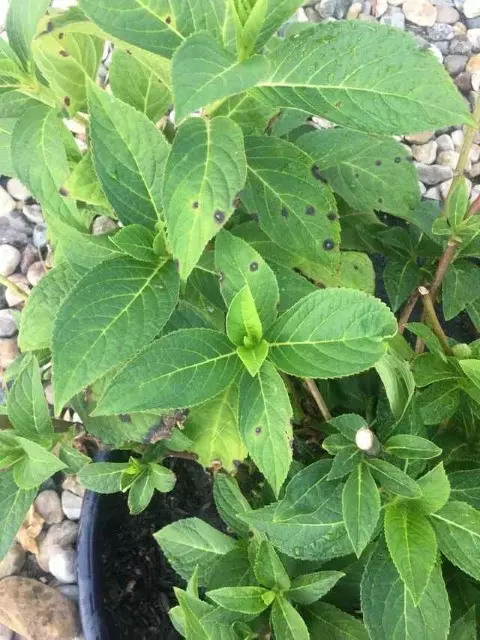
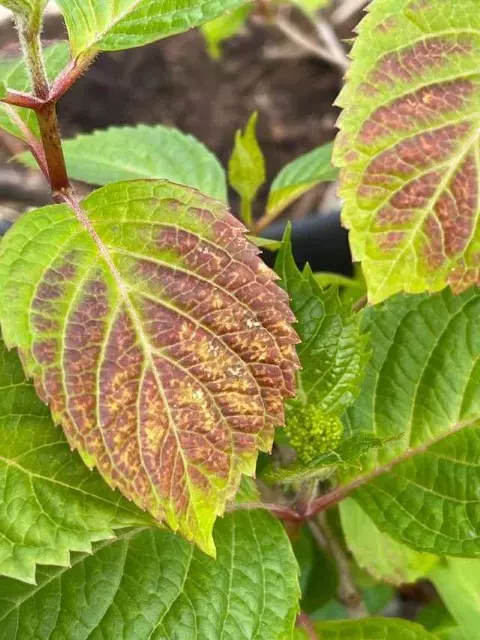
It is often found that when hydrangea leaves turn yellow (and I dare say when the leaves of any other plant turn yellow) they are absolutely susceptible to any infection, such as infections caused by fungi, bacteria, and viruses.
So many times we see a hydrangea that starts with yellow leaves and from one day to the other appear some black spots or brown spots. What happened first? The yellow leaves’ coloration indicates some weakness and susceptibility occurred first, and then it became susceptible to fungi, etc.
Many gardeners choose to fumigate as a first resort. However, the proper treatment corrects the nutrient deficiency of the plant and then removes the invader. There is no point in spraying and fumigating if nutrients are not provided to improve the defenses and condition of the hydrangea. Otherwise, the hydrangea may not recover after fumigating (as we often see) and may not bloom.
How to Fix Yellow Hydrangea Leaves and Brown Spots Due to Nutrient Deficiencies and Fungus
Let’s see the step-by-step to Fix Yellow Hydrangea Leaves and Brown Spots Due to Nutrient Deficiencies and Fungus:
- Trim off all the infected leaves by using disinfected scissors
- Check the stems. If you see fungal spotting on the stems trim those, too
- If possible, make your cuts at a 45-degree angle
- To prevent disease in the hydrangea, apply some cinnamon to the cut
- It is a good practice to sanitize your scissors with ethanol diluted in water (60-70%) between cuts and when leaving the tools in the box
- Remove any fallen leaves from the area around the hydrangea
- Do not use the leaves in compost. Trash it everything
- It is a recommended practice to place some mulch around the hydrangea to prevent the rain from splashing and creating spray onto the foliage
- Apply fertilizer suitable for Hydrangeas
- Then apply a copper fungicide (each spring is recommended if needed)
- I would suggest applying the copper fungicide in the early morning or evenings to prevent sunburn on hydrangea leaves and on non-rainy days to maintain its full effect
- Control fungus and disease in your garden with Captain Jack’s ready-to-use Liquid Copper Fungicide!
- Approved for organic gardening, this fungicide is suitable for the production of organic produce and can even be used up until the day of harvest!
- Copper Fungicide effective in the control and prevention of a wide range of plant diseases. Listed common garden diseases include blight, black spot, powdery mildew peach leaf curl and more.
How Do Prevent Diseases Caused By Fungi, Viruses, And Bacteria That Cause Yellow Leaves In Hydrangeas?
How Do Prevent Diseases Caused By Fungi, Viruses, And Bacteria That Cause Hydrangea Yellow Leaves? Parasitic diseases are challenging to prevent, since we can only detect them in plants through their symptoms, and they are indicators that they have already contracted the disease, so they will only accept the corresponding treatment.
The prevention of parasitic disease is organized on the basis of knowledge of the environment, cultivation techniques, and the culture of prevention and maintenance of tools and working tools.
For example: if we know the environmental conditions conducive to the development of a fungal disease, such as mildew or powdery mildew, we can carry out preventive treatments with a fungicide at the right time to help our plants prevent the attack of these fungi on their leaves.
When plants are affected by an invasive organism, their leaves begin to turn yellow, and spots, dots, or curls appear, as occurs with hydrangea yellow leaves. Therefore, it is recommended to use a copper fungicide for fungal diseases of hydrangeas.
In addition, if we know the vehicles of transmission of pathogens, we can also control the infestation of a parasitic disease in its environment, or help it to move from an infested area to a healthy area.
For example cleaning and disinfecting pruning tools (shears) and cleaning tools (plows and brush cutters) in chestnut groves to prevent the spread of chestnut blight.
Remember that an action as simple as spraying alcohol diluted in water on your pruning shears can prevent the transmission of pathogens from one plant to another.
How do diseases reach plants? The means of transmission of parasitic diseases are the agents that carry the pathogens to the plants and are known as the means of pathogen dispersal.
They are really very basic vehicles of transmission: wind and rain, insect pests, and the action of animals or man. The wind is the means of pathogen dispersal that is most effective in this task. The action of wind moves fungal spores over long distances. It is your responsibility to clean and disinfect your tools and working tools.
How does a disease enter a plant? Once a pathogen reaches a plant through the action of a dispersal medium, inoculation or the process by which a pathogen or a part of it (inoculum) tries to enter the plant and can develop a disease begins.
The action of the pathogen can be direct, degrading the plant epidermis until it achieves its objective, or it can take advantage of an entry door.
Plants naturally have open doors to the introduction of pathogens, such as their stomata (adjustable pores of the plant epidermis). But pathogens can also take advantage of wounds in plants caused by human action or climatic conditions (hail, strong wind…). Once inside the plant, the pathogen will start the incubation process, by which it feeds and develops.
How do pathogens survive outside plants? A pathogen can live outside a plant because of its survival state.
The pathogen will always use its environment as a resource for feeding and development, so it can survive in the organic matter remains without problems, for example in the soil, on decomposing matter.
Other supports for its survival are: plant remains of previously affected plants, damaged roots, and fruits, seeds of infected plants… They could also use insects that have fed on diseased plants (viral diseases).
Defense against parasitic diseases of hydrangeas. Hydrangeas and plants in our garden are living beings that have their own defensive system for defense against diseases.
Internally, the natural defenses of plants are known as biochemical defenses. For example, plants can reject pathogens by losing nutrient properties exclusive to them, or by producing poisonous substances within themselves. Thus, some of these defense mechanisms can be helped by providing nutrients or supplements that recharge the plants’ energies and allow them to maintain their natural defenses active.
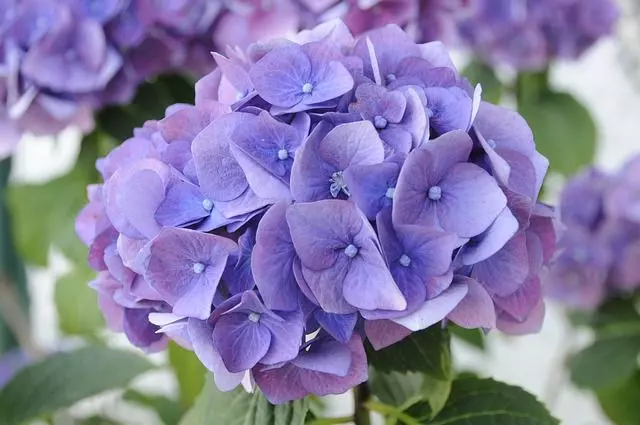
As mentioned at the beginning of the article “Why are my hydrangea leaves turning yellow?” hydrangeas can also have other recurring problems, besides yellow leaves. Check out our recommended articles to learn more about Hydrangeas Care and Common Problems with hydrangeas and How to Fix Them.
We hope this article will be helpful in diagnosing Hydrangea Yellow Leaves and understanding what is wrong with your hydrangea. Do not hesitate to contact us and send us your photos if you need help or if you would like the article to include another related topic.
How to Grow Hydrangea from Cuttings – Easy Method
How to Repot Hydrangeas – When and How
How to Prune Hydrangeas – Guide
Pruning Endless Summer Hydrangeas (Hydrangea macrophylla)




